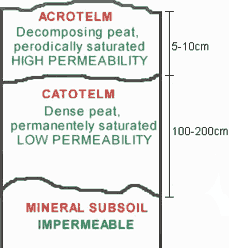The depth of peat and the height of the water table helps to determine the rate at which peat forms and is eroded
Blanket peat has two layers, the acrotelm and catotelm.
The Acrotelm Layer

This is the upper layer of blanket peat.
- It is above the average water table level.
- It is therefore only periodically saturated.
- This allows air into the upper layer.
- Aeration triggers active decomposition (or humification) of the peat.
- The cellulose & lignin of plant tissue break down into humic acids.
- Near surface runoff occurs in the acrotelm layer.
- This may cause peat erosion in some cases where the peat is very dry and loose e.g. in Peat haggs.
- As the layer is periodically permeable, water can also flow laterally through this layer.
The Catotelm Layer
This is the saturated layer of blanket peat below the acrotelm.
- It lies below the water table.
- It is therefore continually saturated.
- This causes the peat to be very dense.
- Water movement is slow in this layer.
Peat formation occurs in this layer as it has low permeability (no water flow) and a low oxygen content (oxygen is required for peat decomposition).
The Water Table
The position of the water table plays a major role in the formation and decomposition of blanket peat.
- It must rise sufficiently to make the catotelm layer thick enough to promote build up of dead plant material.
- It must sink low enough for the acrotelm layer to dry out enough to facilitate its aeration and decomposition.
- The boundary between the acrotelm & catotelm moves up and down with the water table in wetter and drier weather.
- The acrotelm layer is deeper when conditions are dry.
Rates of peat accumulation & humification
The height of the water table and the temperature affect the rate at which peat has accumulated in the past and the degree of decomposition:
| High water table and/or lower temperature | Low water table and/or higher temperature |
|---|---|
| Acrotelm layer thin | Acrotelm layer thick |
| Catotelm layer thick | Catotelm layer thin |
| Fast plant material (peat) accumulation | Slower peat accumulation |
| Little decomposition (due to thin acrotelm) | More decomposition of plant material |
| Poorly humified peat layers | Well humified peat layers |
This explains why we see a mixture of darker, well humified and lighter brown, poorly humified peat within a peat core.